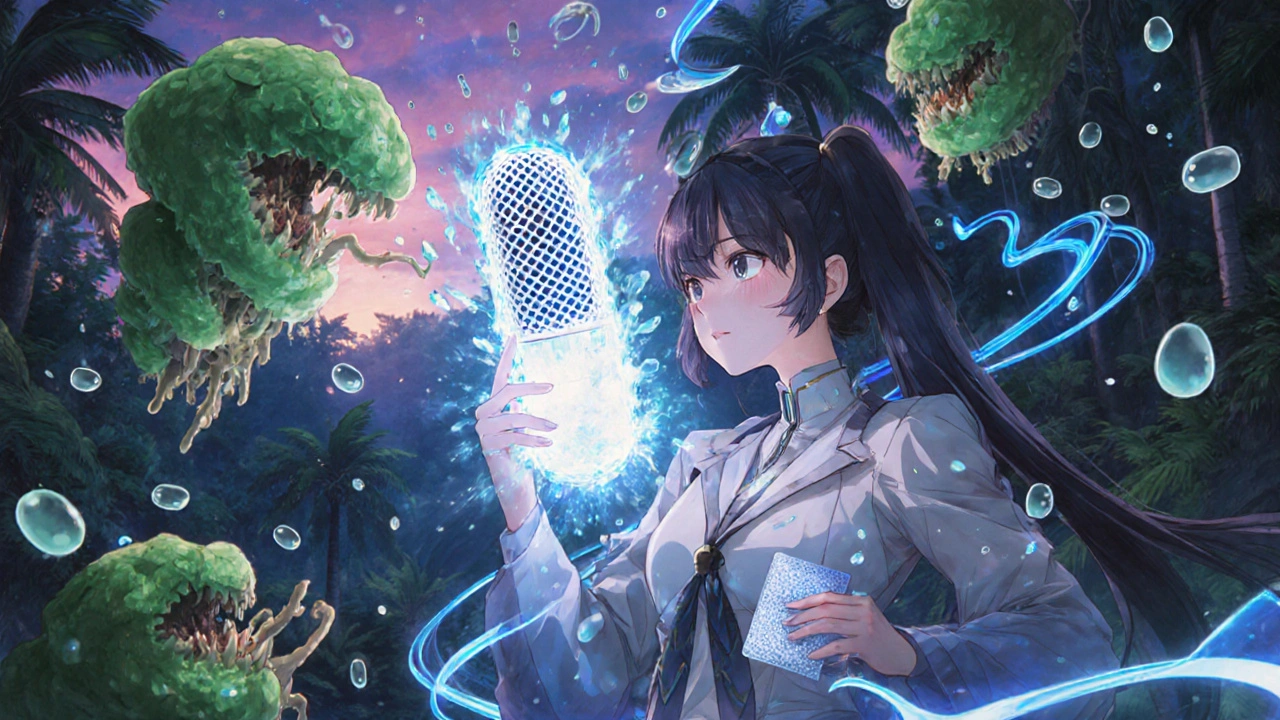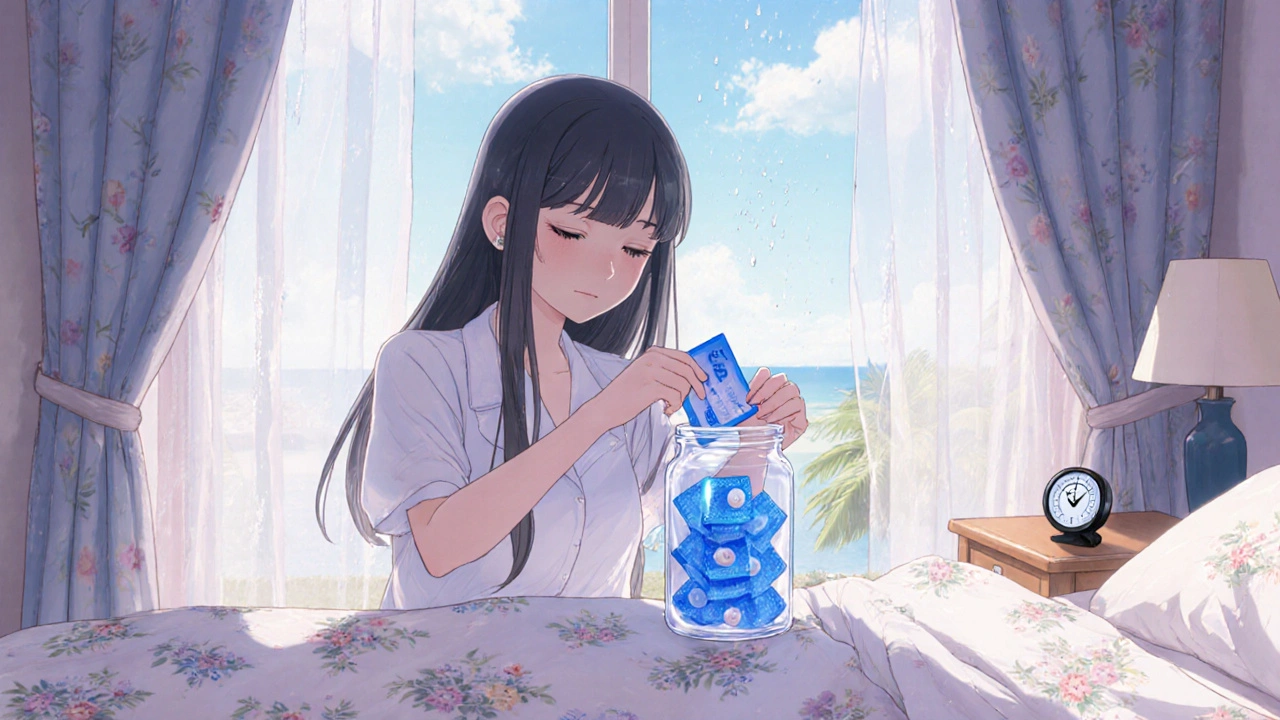When you're traveling to a tropical destination or living in one, your medications aren't just sitting quietly in your bag-they're under attack. High heat and humidity don't just make you sweat; they quietly destroy the pills, capsules, and inhalers you rely on. A tablet that looks fine might have lost half its potency. An inhaler that still clicks might deliver less than a third of the intended dose. This isn't speculation-it's science. And it’s happening more often than most people realize.
Why Tropical Humidity Destroys Medications
Tropical regions aren't just hot. They're wet-often with humidity levels between 70% and 95%. That moisture doesn't just cling to your skin; it seeps into your medicine. The main culprit is hydrolysis, a chemical reaction where water breaks apart the active ingredients in drugs. According to NIH studies, hydrolysis causes about 70% of all moisture-related drug degradation. For example, amoxicillin trihydrate can absorb up to 10% of its own weight in water when exposed to 75% humidity at room temperature. That leads to a 50% drop in potency within 30 days. Other problems include:- Tablets cracking, sticking, or caking together
- Capsules becoming soft, sticky, or leaking
- Powders clumping into unusable lumps
- Inhalers losing fine particle distribution, making them ineffective
- Microbial growth-fungi like Aspergillus can grow on damp pills in as little as 72 hours
Which Medications Are Most at Risk?
Not all drugs are equally vulnerable. Some are like dry sponges for moisture. Here’s what to watch out for:- Antibiotics like tetracycline, amoxicillin, and doxycycline-these degrade fast in moisture, sometimes changing color visibly within two weeks.
- Antifungals such as fluconazole and clotrimazole-highly hygroscopic, meaning they pull water right out of the air.
- Orally disintegrating tablets (ODTs) like Zofran or Rizatriptan-these dissolve on your tongue, so they’re designed to be porous. Humidity makes them harden or take forever to break down.
- Dry powder inhalers (DPIs) like Advair or Symbicort-moisture causes powder particles to stick together, reducing lung delivery by up to 25%.
- Freeze-dried vaccines and biologics-these require humidity below 20% RH. Even brief exposure can ruin them.
- Pediatric formulations-often sweetened or flavored, making them more attractive to moisture and mold.
What’s the Right Storage Environment?
The ideal conditions for storing most medications in tropical climates are:- Humidity: 30-45% RH (relative humidity)
- Temperature: 15-25°C (59-77°F)
- Darkness-65% of drugs break down faster under light
- No direct contact with walls or floors-these are colder and damper

How to Protect Your Medications on the Go
If you’re traveling, your hotel bathroom is the worst place to store medicine. Humidity there often hits 80% or higher after showers. Instead:- Use airtight containers-glass jars with rubber seals or hard plastic boxes with locking lids work best.
- Put in silica gel desiccants. Use 1-2 grams per 100 mL of container space. You can buy small packs from pharmacies or online.
- Replace desiccants every 30 days in humid climates. Once they turn color or feel heavy, they’re full.
- Use humidity indicator cards. These change from blue to pink at 55% RH. If it turns pink, your meds are at risk.
- Store your container in your suitcase, not your bag. Suitcases are more insulated and less exposed to bathroom steam.
- Avoid leaving meds in hot cars or near windows. Even a few hours in 35°C heat can speed up degradation.
Advanced Solutions for High-Value Medications
If you’re carrying expensive or life-saving drugs-like insulin, epinephrine auto-injectors, or HIV antivirals-basic desiccants aren’t enough. Here’s what professionals use:- Aluminum blister packs-these are 99.9% moisture-proof. If your pills still come in plastic bottles, ask your pharmacist for blister packaging.
- Activ-Polymer™ technology-a newer desiccant material developed by Aptar that absorbs 2-3 times more moisture than silica gel. It’s now in some blister packs sold in tropical countries.
- Moisture-scavenging bottle caps-new caps with built-in polymers keep internal humidity below 30% RH for up to 18 months. They’re being rolled out in low-resource settings.
- Graphene oxide coatings-still in testing, but MIT researchers showed these reduce moisture penetration by 99.7% compared to aluminum foil. This could be the future of drug packaging.
What to Do If Your Medication Looks Off
You don’t need a lab to spot damage. Look for:- Tablets that are cracked, discolored, or sticky
- Capsules that are swollen, leaking, or smell odd
- Powders that are clumped like wet sand
- Inhalers that feel heavier or don’t spray properly
- Any visible mold-fuzzy spots, green or black specks

How Clinics in Tropical Countries Handle It
In places with limited resources, health workers use clever, low-cost tricks:- Desiccant closets-metal cabinets lined with 5kg of silica gel, costing about $120 each. They keep humidity at 35-45% RH for months.
- The 30-30 Rule-replace desiccants every 30 days if temperature is above 30°C. Simple, proven, and used in over 15,000 homes in the Philippines.
- PharmaSeal-a reusable desiccant canister that costs $0.85 per unit and lasts six months. Used in 32 tropical countries.
What You Should Do Today
Don’t wait for your meds to fail. Here’s your quick action plan:- Check your medications for signs of moisture damage-look, smell, feel.
- Move them out of the bathroom, kitchen, or windowsill.
- Buy a small airtight container and 2-3 silica gel packs.
- Put a humidity indicator card inside.
- Set a phone reminder to replace the desiccants every 30 days.
- If you’re carrying critical meds, ask your pharmacist for blister packaging.
Can I store my medication in the fridge to avoid humidity?
Only if the label says "refrigerate." Otherwise, it’s risky. Fridges have high humidity, and when you take medicine out, condensation can form on the container and seep inside. Always store in a dry, cool place at room temperature unless instructed otherwise.
Are silica gel packs safe to use with medication?
Yes, as long as they’re pharmaceutical-grade and sealed in their own pouches. Never open or eat them. Just place them in the same container as your meds. They’re non-toxic and widely used by manufacturers.
How do I know if my desiccant is still working?
Silica gel packs often change color-from blue to pink or orange to green-when saturated. If yours doesn’t change, use a humidity indicator card instead. These show blue (dry) to pink (wet) at 55% RH. If it turns pink, replace the desiccant immediately.
Can I reuse desiccant packs by drying them in the oven?
Some silica gel packs can be reactivated by baking at 120°C for 2-4 hours, but only if they’re labeled as reusable. Most single-use packs are not designed for this. For safety, replace them every 30 days in tropical conditions.
What if I can’t find silica gel where I am?
Use a clean, dry cloth or paper towel wrapped tightly around your medicine bottle and place it in a sealed container. It won’t be as effective, but it helps reduce moisture. Better yet, ask a local pharmacy-they often have desiccants for sale. In many tropical countries, they’re common in medicine storage kits.
Do all medications degrade the same way in humidity?
No. Solid tablets with anhydrous lactose degrade faster than those with microcrystalline cellulose. Liquid suspensions, creams, and injectables have different risks. Always check the storage instructions on the label. When in doubt, assume humidity is a threat and take precautions.
Next Steps for Travelers and Residents
If you’re planning a trip to a tropical country:- Bring 10-20% extra medication in case of loss or degradation.
- Ask your pharmacist for blister-packed versions before you leave.
- Carry a small digital hygrometer to check humidity levels in your room.
- Keep a list of local pharmacies and emergency contacts where you’re going.
- Work with your clinic to install a desiccant closet if you store bulk meds.
- Advocate for blister packaging in your local pharmacy.
- Teach family members to check for signs of moisture damage monthly.


David Cunningham
Been using silica gel in my pill case since I moved to Bali last year. Game changer. No more sticky amoxicillin. Also bought those humidity cards-they turn pink way too often in my bathroom. Learned the hard way.